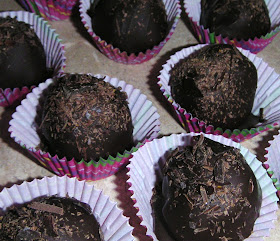My obsession with chocolate making started many years ago, and it's really only gotten worse. I've made them for gifts, and still do. I've sold them to small cafes, at stands for holidays, and at farmer's markets. I've taught others how to make them. Yes, it's a mess, but it smells so delicious that it's really worth it. And, if you line your counters with parchment paper, the clean-up isn't really so bad. This version of chocolate ganache is what I use as the basis for most of the many flavors and types of chocolates that I make. It also is divine as a glaze on cake or whipped to fill or frost a cake as well. Enjoy!
Heat to a boil over med-high heat in a small frying pan or sauce pan:
Remove from heat and add:
Stir gently until smooth (this may take a few minutes, especially for the milk chocolate).
For truffles (dipped in non-tempered chocolate – see note below*):
Roll into balls (you can use spoons or a mini cookie scoop to help here). Place ganache balls on a parchment-lined baking sheet. Refrigerate, again, until firm.
Prepare any toppings you might want to use to sprinkle on top of the truffles or roll the chocolate-dipped truffles in. These may include:Sprinkles
Once melted, mix in 1 tsp extra light olive oil. This helps your chocolate to stay looking nice and smooth, since you’re not properly tempering the chocolate (see note below*).
Prepare a new cookie sheet lined with parchment paper to place dipped truffles.
Add toppings now if desired, before the chocolate has a chance to set. If rolling in toffee bits, do that immediately after dipping and use a small bowl for the toffee bits (just keep refilling) since it does tend to get chocolate-covered after awhile.
A selection of chocolate truffles with varying decorations.
Dark
or Milk Chocolate Ganache
This recipe has 3 uses:
1. Truffle filling – aka, what is
inside chocolates.
2. Poured while still warm (not hot)
over cake to form smooth frosting
3. Cooled, then whipped and used as
filling or frosting on cake.
Heat to a boil over med-high heat in a small frying pan or sauce pan:
¼
cup butter
¼
cup heavy cream
Remove from heat and add:
4 oz
dark or semi-sweet chocolate or 5 oz milk chocolate (use high quality
chocolate)
Stir gently until smooth (this may take a few minutes, especially for the milk chocolate).
For truffles (dipped in non-tempered chocolate – see note below*):
Pour your ganache into a low, wide
bowl. Refrigerate until firm.
Roll into balls (you can use spoons or a mini cookie scoop to help here). Place ganache balls on a parchment-lined baking sheet. Refrigerate, again, until firm.
Prepare any toppings you might want to use to sprinkle on top of the truffles or roll the chocolate-dipped truffles in. These may include:
A
bit of chocolate, to be melted, to drizzle (dark, milk or white)
Transfer sheets (don't work as well on rounded chocolates)
Cocoa powder/powdered sugar
Melt high quality dark (or milk) chocolate in 30 second increments
at 50% power in the microwave, stirring after each 30 seconds. (I tend to use a cereal
bowl ¾ filled with chocolate. You can always add more chocolate and melt more).
You don’t want to over-heat chocolate or
it burns, thickens, and needs to be thrown out!
Once melted, mix in 1 tsp extra light olive oil. This helps your chocolate to stay looking nice and smooth, since you’re not properly tempering the chocolate (see note below*).
Prepare a new cookie sheet lined with parchment paper to place dipped truffles.
Dip your cold ganache balls into the
melted chocolate using 2 forks. I like
to primarily use one fork for dipping, tapping the fork on the side of the bowl
to remove excess chocolate, and then using the second fork to help carefully remove the chocolate covered
truffle onto your parchment paper.
Store dipped truffles 2 weeks at RT or
1 month in the refrigerator.
* Tempering
chocolate is a method where you heat up, cool, and re-heat the chocolate in
a particular manner so when the chocolate hardens it looks nice and smooth and
doesn’t have streaks in it. It also has a bit of a crunch to it when you bite
it. (That crisp snap of an expensive chocolate bar happens because the chocolate
has been properly tempered.) Tempering
also keeps the chocolate from having discoloration or streaking. Those streaks
are perfectly OK to have in your chocolate and won’t affect the taste at all. However,
it does make it look rather funny. So it’s
nice to temper chocolate if you have the time.
Adding a bit of oil to your melted chocolate helps create a ‘fake’
temper. It’s not perfect, but it often
keeps the streaks from occurring. Some
people use the chocolate that specifically says it’s made for ‘candy molding’.
Personally, I think it tastes terrible, but it’s formulated so you don’t get
streaks or discoloration, so is the easy solution to chocolate making. Personally, I stick to adding a little oil if
I’m pressed for time and save the tempering for my big chocolate-making extravaganzas near holidays.
.JPG)






No comments:
Post a Comment